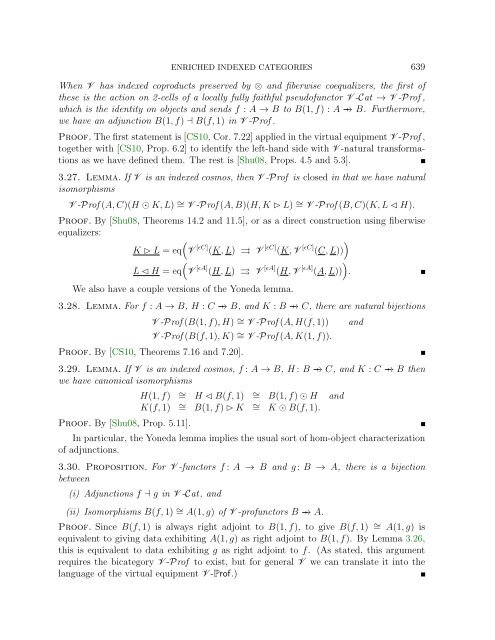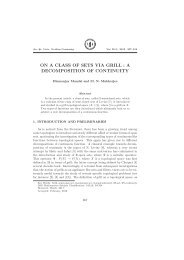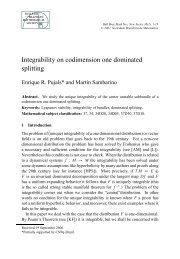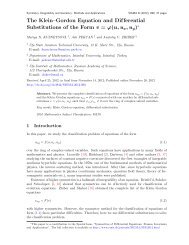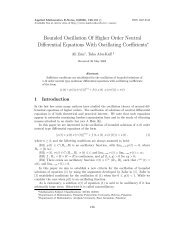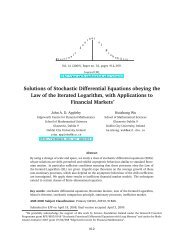ENRICHED INDEXED CATEGORIES Contents 1. Introduction
ENRICHED INDEXED CATEGORIES Contents 1. Introduction
ENRICHED INDEXED CATEGORIES Contents 1. Introduction
Create successful ePaper yourself
Turn your PDF publications into a flip-book with our unique Google optimized e-Paper software.
<strong>ENRICHED</strong> <strong>INDEXED</strong> <strong>CATEGORIES</strong> 639When V has indexed coproducts preserved by ⊗ and fiberwise coequalizers, the first ofthese is the action on 2-cells of a locally fully faithful pseudofunctor V -Cat → V -Prof ,which is the identity on objects and sends f : A → B to B(1, f) : A −→ −↦ B. Furthermore,we have an adjunction B(1, f) ⊣ B(f, 1) in V -Prof .Proof. The first statement is [CS10, Cor. 7.22] applied in the virtual equipment V -Prof ,together with [CS10, Prop. 6.2] to identify the left-hand side with V -natural transformationsas we have defined them. The rest is [Shu08, Props. 4.5 and 5.3].3.27. Lemma. If V is an indexed cosmos, then V -Prof is closed in that we have naturalisomorphismsV -Prof (A, C)(H ⊙ K, L) ∼ = V -Prof (A, B)(H, K ⊲ L) ∼ = V -Prof (B, C)(K, L ⊳ H).Proof. By [Shu08, Theorems 14.2 and 1<strong>1.</strong>5], or as a direct construction using fiberwiseequalizers:()K ⊲ L = eq V [ɛC] (K, L) ⇒ V [ɛC] (K, V [ɛC] (C, L))()L ⊳ H = eq V [ɛA] (H, L) ⇒ V [ɛA] (H, V [ɛA] (A, L)) .We also have a couple versions of the Yoneda lemma.3.28. Lemma. For f : A → B, H : C −→ −↦ B, and K : B −→ −↦ C, there are natural bijectionsV -Prof (B(1, f), H) ∼ = V -Prof (A, H(f, 1))V -Prof (B(f, 1), K) ∼ = V -Prof (A, K(1, f)).Proof. By [CS10, Theorems 7.16 and 7.20].3.29. Lemma. If V is an indexed cosmos, f : A → B, H : B −→ −↦ C, and K : C −→ −↦ B thenwe have canonical isomorphismsProof. By [Shu08, Prop. 5.11].H(1, f) ∼ = H ⊳ B(f, 1) ∼ = B(1, f) ⊙ H andK(f, 1) ∼ = B(1, f) ⊲ K ∼ = K ⊙ B(f, 1).In particular, the Yoneda lemma implies the usual sort of hom-object characterizationof adjunctions.3.30. Proposition. For V -functors f : A → B and g : B → A, there is a bijectionbetween(i) Adjunctions f ⊣ g in V -Cat, and(ii) Isomorphisms B(f, 1) ∼ = A(1, g) of V -profunctors B −→ −↦ A.Proof. Since B(f, 1) is always right adjoint to B(1, f), to give B(f, 1) ∼ = A(1, g) isequivalent to giving data exhibiting A(1, g) as right adjoint to B(1, f). By Lemma 3.26,this is equivalent to data exhibiting g as right adjoint to f. (As stated, this argumentrequires the bicategory V -Prof to exist, but for general V we can translate it into thelanguage of the virtual equipment V -Prof.)and


